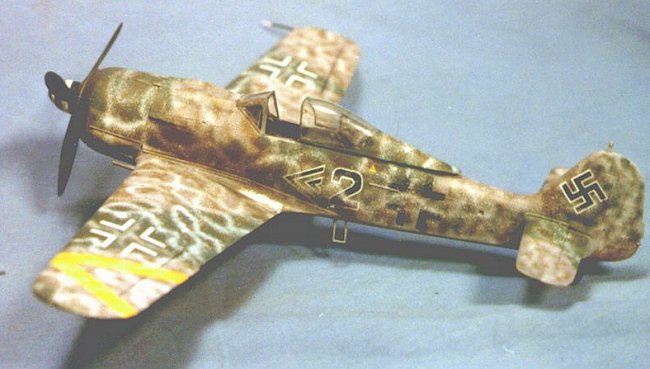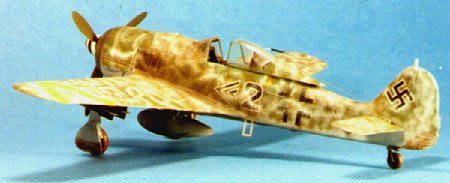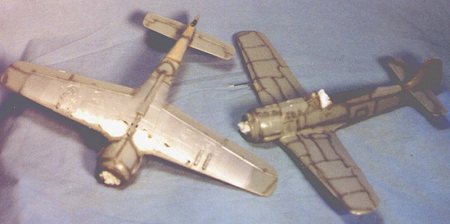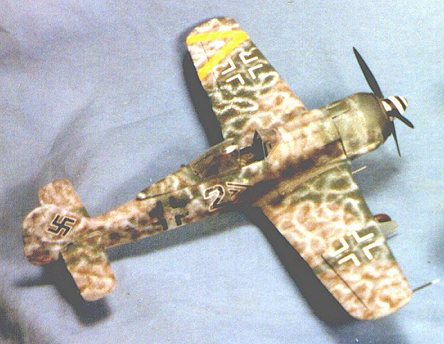
| Luftwaffe Winter Camouflage Schemes: Part 2 |
| Late War Schlactflieger |
| Fw-190F-8 |
| Tom Cleaver |

Beyond the fact that the German aircraft industry stayed on the cutting edge of development throughout the 1939-45 period, thus creating many technically or aeronautically-interesting aircraft, the Luftwaffe was very camouflage-conscious from 1938 onward, creating many specialized schemes appropriate to different regions where it found itself fighting, schemes that had no counterpart among the RAF or USAAF. These various interesting schemes have attracted modelers since back in the days when everyone thought the basic colors were dark green, black-green and blue. Now that we know the myriad of possible colors at various times during the war, Luftwaffe modeling is more popular than ever and shows no signs of dissipating.
While the Germans, particularly on the Eastern Front, used some relatively complex winter camouflage schemes, by the last winter of the war these schemes were not seen as frequently as before. The was primarily due to the fact the Luftwaffe ground crew didn't have the time to paint careful schemes, followed by the fact there wasn't much of the necessary paint available. The result was that the "full winter" camouflage was replaced with makeshift schemes capable of being created with the time and material resources available.
 A common camouflage scheme throughout the war from 1941 onwards was what is
known as "scribble." This got its start with maritime units, but once
it was seen how effective this type of camouflage was, it spread to all the
various Luftwaffe units. The Schlactflieger - the ground attack units
operating primarily on the Eastern Front - were no different. From the summer of
1944 onward, there is photographic evidence of various "scribble"
schemes being used to make the Fw-190s - still being delivered in the air
superiority scheme of RLM 74/75/76 greys - less visible while on the ground. The
Luftwaffe was now subject to airfield attacks, and it was more important to save
the airplanes from strafing attacks than to worry about how
"invisible" they might be in aerial combat.
A common camouflage scheme throughout the war from 1941 onwards was what is
known as "scribble." This got its start with maritime units, but once
it was seen how effective this type of camouflage was, it spread to all the
various Luftwaffe units. The Schlactflieger - the ground attack units
operating primarily on the Eastern Front - were no different. From the summer of
1944 onward, there is photographic evidence of various "scribble"
schemes being used to make the Fw-190s - still being delivered in the air
superiority scheme of RLM 74/75/76 greys - less visible while on the ground. The
Luftwaffe was now subject to airfield attacks, and it was more important to save
the airplanes from strafing attacks than to worry about how
"invisible" they might be in aerial combat.
This Tamiya Fw-190F-8 is in the 1944 scheme of RLM74/75/76, with a RLM81 "scribble" over the factory scheme. As a temporary "winter" scheme, white paint has been "scribbled over this scheme, very haphazardly, with no worry about overpainting the national insignia. Additionally, this airplane demonstrates its late war status by the fact that the wheel wells are no longer painted RLM02, and that the main lower wing area - between the forward and rear main spars, has been left natural metal.
 I accomplished this scheme by starting from the bottom up. First off, I
"preshadowed" all panel lines on the aircraft with flat black. I then
sprayed the underside of the wing and the wheel wells with SnJ aluminum. This is
by far the best metalizer paint to use as a "base coat," since you can
mask over it with no fear of it coming off the plastic surface when you lift the
drafting tape; in fact, you can successfully mask with super-sticky masking tape
when you're using SnJ aluminum paint. I masked off this area when the paint was
dry, and then shot Gunze-Sanyo H-419 RLM76 "Hell Grau". When that was
dry I started in on the upper camouflage scheme. I use Gunze-Sanyo H-53
"Neutral Grey" for RLM75 "Grauviolett", due to its distinct
purplish tint, which is not in the color Gunze created earlier as RLM75. I make
RLM74 "Graugrun" by mixing Gunze H-74 "IJN Green" 50-50 with
Gunze H-335, "Blueish-Grey;" since this color was subject to fading,
you cannot be held to a particular tone - if the Kolourpolizei try to
give you trouble, ask them if they were there, and then ask them to point out
their model (since the penlight morons never build anything, that's
guaranteed to send them scuttling back under the rock they came from). I painted
the upper camouflage per the standard Focke-Wulf camo pattern, with a heavy dose
of mottling on the fuselage side, a hallmark of the 1944 factory scheme. I ten
masked off the forward cowling and sprayed the nose ring with RLM66.
I accomplished this scheme by starting from the bottom up. First off, I
"preshadowed" all panel lines on the aircraft with flat black. I then
sprayed the underside of the wing and the wheel wells with SnJ aluminum. This is
by far the best metalizer paint to use as a "base coat," since you can
mask over it with no fear of it coming off the plastic surface when you lift the
drafting tape; in fact, you can successfully mask with super-sticky masking tape
when you're using SnJ aluminum paint. I masked off this area when the paint was
dry, and then shot Gunze-Sanyo H-419 RLM76 "Hell Grau". When that was
dry I started in on the upper camouflage scheme. I use Gunze-Sanyo H-53
"Neutral Grey" for RLM75 "Grauviolett", due to its distinct
purplish tint, which is not in the color Gunze created earlier as RLM75. I make
RLM74 "Graugrun" by mixing Gunze H-74 "IJN Green" 50-50 with
Gunze H-335, "Blueish-Grey;" since this color was subject to fading,
you cannot be held to a particular tone - if the Kolourpolizei try to
give you trouble, ask them if they were there, and then ask them to point out
their model (since the penlight morons never build anything, that's
guaranteed to send them scuttling back under the rock they came from). I painted
the upper camouflage per the standard Focke-Wulf camo pattern, with a heavy dose
of mottling on the fuselage side, a hallmark of the 1944 factory scheme. I ten
masked off the forward cowling and sprayed the nose ring with RLM66.
 I then cleaned out the brush thoroughly (since I use a Paasche Model H,
that's easy - disassemble, clean, reassemble) and got ready to do the scribble.
I used Gunze-Sanyo H-421 RLM81 "Braunviolett", thinned aabout 40-60
with rubbing alcohol. When I do the "scribble", I pretend I am one or
two junior enlisted men with spray guns, one starting on one wing trip, one on
the other, each painting about half the airplane; that way the scheme becomes
very haphazard, which is the hallmark of a good "scribble." I then
applied a coat of Future over the camouflage.
I then cleaned out the brush thoroughly (since I use a Paasche Model H,
that's easy - disassemble, clean, reassemble) and got ready to do the scribble.
I used Gunze-Sanyo H-421 RLM81 "Braunviolett", thinned aabout 40-60
with rubbing alcohol. When I do the "scribble", I pretend I am one or
two junior enlisted men with spray guns, one starting on one wing trip, one on
the other, each painting about half the airplane; that way the scheme becomes
very haphazard, which is the hallmark of a good "scribble." I then
applied a coat of Future over the camouflage.
I then applied the markings. These mostly came from the decal dungeon, as I have yet to find an aftermarket decal sheet that does the Fw-190F-8. Since the airplanes were almost all very anonymous so far as personal markings were concerned by this time of the war, it's not a problem. When the decals were dry, I applied another coat of Future over them.
The "winter scribble" was applied very haphazardly, and it did not matter if it went over the markings. This was done from a photograph and inspired by a profile in the Osprey "Aircraft of the Aces" series, "Fw-190 Aces of the Eastern Front." The airbrish was tightened way down, so that the paint came out almost "spitting."
 Once that was done, I dry brushed mud smears on the lower wing behind the
main gear and rudder behind the tail wheel, and muddied up the gear doors. I
gave a light coating of Tamiya "Smoke" over the exhaust area, since
the BMW-801 was such a "dirty" engine, as well as streaming it back
along the underside of the fuselage from the lower exhausts. I then sprayed the
whole model with "Flat Future," Future mixed 50-50 with Tamiya Flat
Base. When that was done, I sprayed a thin coat of gloss Future over the exhaust
areas to bring up a different surface finish and simulate the oiliness of the
exhaust stain.
Once that was done, I dry brushed mud smears on the lower wing behind the
main gear and rudder behind the tail wheel, and muddied up the gear doors. I
gave a light coating of Tamiya "Smoke" over the exhaust area, since
the BMW-801 was such a "dirty" engine, as well as streaming it back
along the underside of the fuselage from the lower exhausts. I then sprayed the
whole model with "Flat Future," Future mixed 50-50 with Tamiya Flat
Base. When that was done, I sprayed a thin coat of gloss Future over the exhaust
areas to bring up a different surface finish and simulate the oiliness of the
exhaust stain.
Since the Fw-190F-8 used the blown hood, I created the "flopping" antenna wire by smearing some C-A glue on nylon repair thread, then holding it so it curled around until the glue dried. I cut a length and attached this to the canopy and rudder, holding it so it fell against the fuselage until the glue set up.
There you have it: late war winter camouflage as used by the Schlactflieger.